As an Amazon Associate I earn from qualifying purchases.
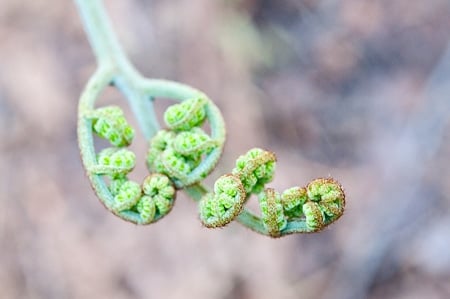
I eat a known carcinogen every spring. But then again, chances are, so do you.
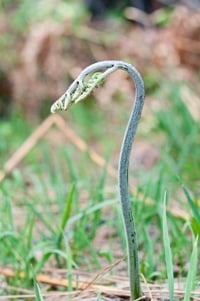
Few wild plants are as polarizing as bracken fern, Pteridium aquilinum. It is a global species, living everywhere but the harshest deserts and the coldest tundra. Here in California, it is ubiquitous. I find its fiddleheads — odd looking fiddleheads, like an eagle’s clenched talon — in Point Reyes as early as late February and as late as mid-June in the High Sierra.
That means if you wanted, you could eat bracken fern fiddleheads for four straight months here in California. You could, but you shouldn’t.
Bracken fern does indeed contains carcinogens, that much is clear. I’ve been spending a lot of time in the past week reading scientific papers with names like “Induction of Tumors in ACI Rats Given a Diet Containing Ptalquiloside, a Bracken Carcinogen.” Breezy reading, this. But the slog has been worth it, if only because I refuse to trust the internet and my fellow foraging writers outright. Bracken is so controversial you will see them writing statements ranging from “eat it as much as you want, it’s fine,” to “never, ever, ever eat bracken, raw or cooked.”
And like most black-and-white statements, both are wrong.
After a pretty exhaustive — and exhausting — survey of the literature, it seems pretty clear that a typical forager’s diet of bracken fiddleheads, blanched and sauteed with lots of butter (or whatever) is perfectly safe. Before you start shouting at me, let me explain.
The primary villain lurking within bracken fern is a substance called ptalquiloside. It is, by all accounts, nasty stuff. And bracken fiddleheads are packed with it, up to 0.8 percent by dry weight, according to some studies. But therein lies the first caveat: A raft of other studies shows that ptalquiloside levels vary wildly in bracken stands. Some in New Zealand were even found with none of the stuff at all. So you really have no idea how much — if any — of the carcinogen lies within your pretty fiddlehead.
It is abundantly clear, however, that if you eat raw bracken fiddleheads in the woods you will probably ingest ptalquiloside. And that’s not good eats.
But ptalquiloside has two properties that are of interest to us:
- First, it is water soluble. That means if you soak bracken fiddleheads in cool water (cool to keep them crunchy), and change that water every so often, you will greatly reduce the level of ptalquiloside in the fiddlehead; the Japanese often eat bracken this way.
- Second, ptalquiloside is notoriously volatile at normal temperatures. The pure stuff degenerates at room temperature, which is why the scientists doing the rat studies store their palquiloside at -20 degrees Celsius. Once exposed to boiling temperatures, the carcinogen denatures almost completely. Salt and baking soda increase this effect.
What this means is that a very normal cooking process for fiddleheads — blanching in salty water, then shocking in ice water, then sauteeing — renders the fiddlehead close to harmless.
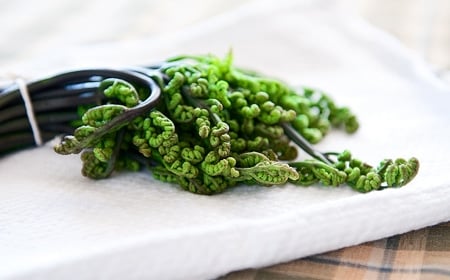
Note that I say “close to harmless.” The reason we know that bracken can cause cancer is not only because of all sorts of livestock studies — cows sometimes eat the fully grown fronds and get urinary tract cancers — but also because bracken is widely eaten in Korea, Japan and parts of China. And when I mean “widely,” I mean almost every day in some cases. Bracken (gosari) is a classic part of bibimbap, one of the most famous Korean dishes there is.
Indeed, my friend and fellow forager Langdon Cook likes to eat his bracken Asian style.
Most of the research has been done by Japanese and Koreans, searching for clues as to why they seem to have high rates of throat and stomach cancer. Apparently there are a kaleidoscope of reasons, and habitual bracken-eating is among them. Like anything, ptalquiloside’s poison is in the dose. The body can process out only so much of the stuff, and constant eating of bracken puts too much ptalquiloside in the system — that’s what causes cancer.
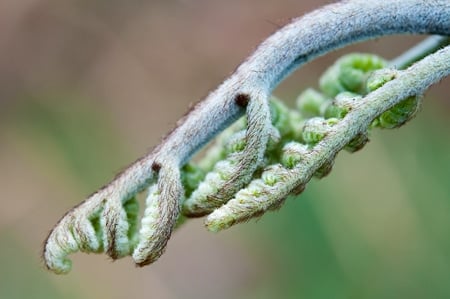
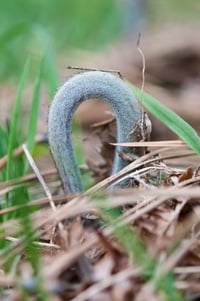
I know what you are saying. Why even mess with this crazy bracken thing? Why even put myself at risk?
Several reasons. First, bracken tastes wonderful, like asparagus, almonds and Tuscan black kale all rolled into one. Second, eating bracken is akin to drinking alcohol: Done responsibly, it is enjoyable and perfectly safe. But just as you would not rationally decide to drink a case of beer every day for a month, you would not rationally choose to eat a big plate of bracken ferns every day during the fiddlehead season. The carcinogen is no stronger than that in alcohol, and many of us drink that every day.
I choose to eat bracken fiddleheads. How often? Maybe a handful of times a year. Go for it. Eat them once and you will see what all the fuss is about. Just remember your Aristotle: All Things in Moderation.
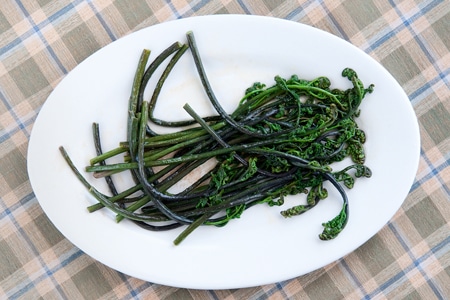
[recipe_name]Bracken Fiddleheads with Butter[/recipe_name]
[summary]Bracken fern is as good to eat as it is beautiful, but you need to take some special steps in cooking it to diminish its harmful properties. Once you do this, it is best to just simply cook these pretty things and enjoy their flavor, which is a combination of asparagus, almonds and kale. Truffle butter seemed like a natural choice as a flavoring — regular butter and truffle salt is a good alternative. No truffle products? Just use the best butter you can afford and a nice fleur de sel. Splurge! After all, you should only eat bracken a few times a year, so enjoy it![/summary]
[yield]Serves 2.[/yield]
Prep Time:[preptime time=1H] 1 hour[/preptime]
Cook Time:[cooktime time=5M] 5 minutes[/cooktime]
- [ingredient]3/4 to 1 pound young bracken fiddleheads[/ingredient]
- [ingredient]Salt[/ingredient]
- [ingredient]3 tablespoons truffle butter[/ingredient]
[instructions]
- Trim the bracken fiddleheads to an even length. Bring a large pot of water to a boil and add enough salt to make it taste like the sea. Fill a large bowl with ice water. Boil the bracken for 2 minutes, then plunge into the ice water. let them sit in the water for 45 minutes. Pat dry.
- Heat half the truffle butter in a large saute pan over medium-high heat. Saute the fiddleheads for 4-5 minutes, flipping them from time to time. Sprinkle some salt over them. Turn off the heat and add the remaining butter. Swirl to coat the fiddleheads with the butter as it melts. Eat at once.
[/instructions]
More Recipes For Foraged Foods
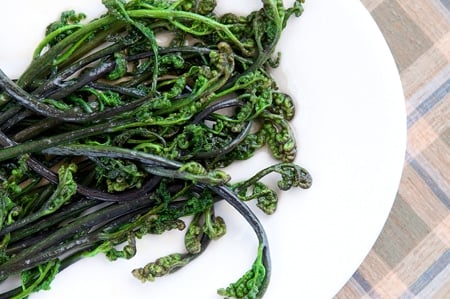




Thanks for this very thorough and readable post. I think we have bracken growing nearby here in Dorset, UK and will look forward to trying your cooking method soon.
Wow, neat post! I just got referred to read it when I had posted on PlantForagers about Sam Thayer’s write-up about bracken fern (https://foragersharvest.com/fern-fiddleheads-the-succulent-stalks-of-spring), and saw WildFoodGirl’s post (https://tech.groups.yahoo.com/group/PlantForagers/message/644) referring to here. As best as I can tell, boiling them releases the substance that’s of concern, such that seared meat is more concerning.
A really interesting read, i look forward to giving this a try in 2013 x
Melissa: Sure, you can cite the web discussion. As for my citations, I will look to see if I still have my file on them. All are on the web, however, even though some are in scientific journals. I used Google “Scholar” searches a lot…
Hank, I found this post to be very interesting and I’m working on a paper write now for an academic journal. I can site your web discussion, but I’m also wondering if you would share the citations or links to the studies your reference …??
Thanks. Melissa
PS — I know you’re onto other edibles, but you might also find these studies by my colleagues on bracken uses in Southern CA interesting:
https://www.fs.fed.us/pnw/ruwit/papers/blahna/Anderson%20et%20al-Fern%20Gathering-2000.pdf
The heads can be removed as an extra precaution. Here is how I (Japanese) prepare bracken before the main cooking. https://recipesfortom.blogspot.com/2012/05/warabi-bracken-prep.html
By the way, the plant is very poisonous to animals that eat it, especially horses (and I sure wouldn’t want my meat animals eating it, even if it didn’t kill them). If you have animals who forage in bracken areas, PLEASE see https://www.merckvetmanual.com/mvm/index.jsp?cfile=htm/bc/210400.htm
What a wonderful article. I had no idea fern bracken contained carcinogens. My family is Korean American, and, as you mentioned, it’s pretty much a staple in some of my favorite dishes, especially Yuke-jang (fiery hot beef soup).
Bracken comes second to my all time favorite though…sweet potato stems. I hope there’s nothing lurking in them as well. 😉
Hank, what we do here in Japan, at least in my home, is soak them in water with a little ash added to it. This seems to be a common treatment for a lot of sansai (wild edibles). Warabi mochi is delicious– you’ve gotta try it, although I think it’s made with the roots if I’m not mistaken.
Melissa: I’ve heard about that stuff, but have never eaten it. It’s on the list, though… 😉
Marie: Just make sure the fiddleheads are tightly closed, like in the pictures. Try a small plate and see if you like them first before gorging on bracken. A few people get an upset stomach from eating even a little — this “eat a little before you eat a lot” rule is always good to follow with new foods.
Marsha: You make some excellent points. Yes, it is possibly true that the ptalquiloside is somehow bound in the bracken by other substances within the fern, but there is a lot of science showing that boiling the fiddleheads dramatically reduces ptalquloside levels.
Josh: Clearly. 😉
“But just as you would not rationally decide to drink a case of beer every day for a month…”
Well, it’s obvious YOU didn’t grow up in Rio Vista.
Great post! Much to the annoyance of my friends/family, I’m always asking “and where did you hear/read that?” Knowing your source is so important, it’s one of the lessons from school that sticks with me the most. Do your own research, ask questions, and don’t take something as truth just because it’s on wikipedia. 🙂
Thanks so much for posting this, Hank. We have a veritable bracken fern farm out here – an entire hillside stand of it. I’ve wondered what it is and whether it’s edible – and now I know. I think next Spring we’ll try it at least a few times!
Thanks Hank for taking the time to read the original research papers, I appreciate that – now I don’t have to ;o) But, I do want to point out that the practical conclusions you draw from them may be premature. First, I assume that the characteristics described by the researchers are for the free, purified ptalquiloside they used in their experiments, and that in the natural state in the plant it may be complexed in such a way that just soaking in water may not free it up enough to leach out of the plant to dissolve. The same holds true for the “volatile at normal temperatures,” they are describing a free compound sitting open on the bench – not bound up in the plant. This is NOT to say that your conclusions are not valid, just that the only way to know would be to measure the amounts of ptalquiloside left in the water-soaked and/or sauteed fiddle heads. Keep up the great work, you have a great site here!! I never heard of bracken fern, but now I’m going to be on the look out for it on my next walk in the woods!
Thanks for this Interesting read, it gives answers to a question I always forget to look up. Let’s see if there is still any young bracken fern around here!
Potentially poisonous foods are always more fun to eat. 😉
Thanks for the interesting post — I have been put off eating bracken because of all the contradictory info on the web, but I think it’s time to give them a try. After all, I live in a temperate rainforest, with ferns literally surrounding me. Once or twice certainly won’t kill me! Theresa
Beautiful photos and great information! I’ve wondered about bracken fern; we have loads of it growing here in the forest. I’ll try some this year… carefully. 😉
Interesting stuff. I’d never even heard that there was any carcinogenic attribute to these ferns. I’ve been using them over the past year or so as a bi bim bap ingredient. They come dried, so I prepare them by pouring over boiling water several hours before I want to use them, and changing the water once or twice. Frankly, I was changing the water because the initial boiling water took on a sort of funky, marshy smell from the dried ferns, which didn’t really appeal to me. Good to know that my method was getting rid of some potential nasties in the process of getting rid of that odor.
I didn’t know you could find this in the US. A fantastic Japanese dessert is mochi made with bracken flour called Warabimochi. It’s a very expensive treat, but worth it for its delicious earthy complexity. I would suspect the starch-making process decreases toxins as well.